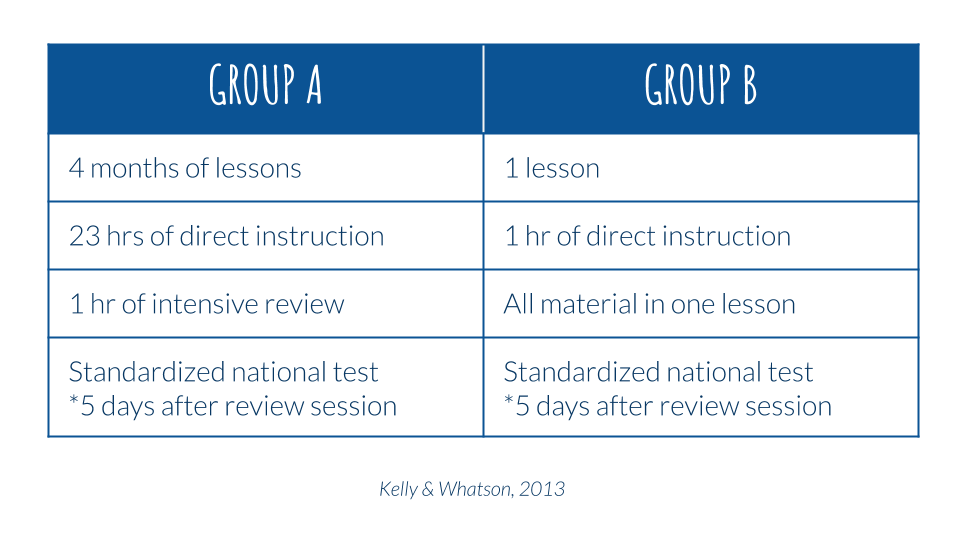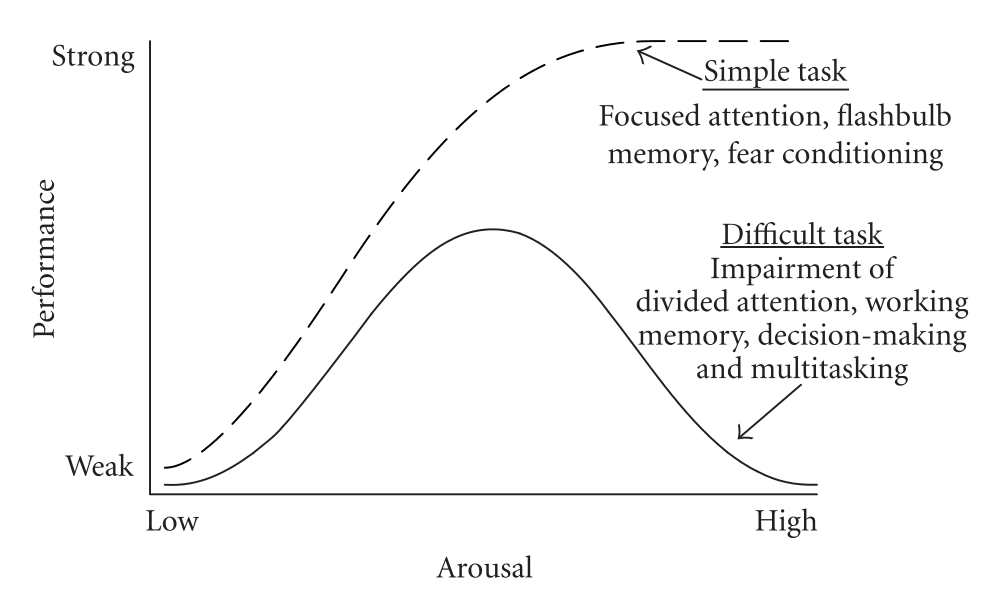Spaced Learning
Previously we introduced long-term potentiation (LTP) as a mechanism that makes the connections among brain cells more permanent. LTP is the process of synthesizing or creating proteins in the synapses (connections between brain cells) to make them more permanent. Previously, many believed that long-term memory formation took days or longer to form in humans. However, more recent research suggests that LTP can be triggered in a short period of time by a specific pattern of activation (Fields, 2005). The pattern, much like a recipe, was three ‘activations’ separated by two 10-minute gaps. “New research into the neuroscience of learning has now identified how long-term memories can be made in minutes rather than days and for complex topics, not just basic associations” (Ferguson et al., 2017).

What would happen if such a pattern was applied in a formal educational setting? Kelley and Whatson (2013) applied this recipe (and called Spaced Learning) in a study conducted with high school students (age 13-15) in the United Kingdom. Students were enrolled in a national curriculum biology course and were randomly assigned to one of three groups (N = 1700+). Group A completed 4 months of regular biology lessons (23 hrs of direct instruction). Their final lesson was a standard 1-hour review class. Group B completed a single, 1-hour lesson (1 hour of direct instruction). All the material for the course was condensed into the single lesson that followed the Spaced Learning pattern. Group C completed 4 months of regular biology lessons (23 hrs of direct instruction). Their final lesson was a Spaced Learning 1-hour review class. Five days after each group’s review sessions, all students took a standardized national test on biology. What were the results of the study? Group B performed as well as Group A despite experiencing 22 fewer hours of instruction. Group B had 1 day instead of 4 months of study. Yet, Group C performed best of all. The class average increased by over 7 points just by modifying the design of the review class. So, if you teach courses, perhaps, consider spaced learning for the first and/or last lesson to better support students in forming LTM.

What could a Spaced Learning lesson look like? (1) The teacher presents key facts or information for 20-30 minutes. (2) Students are given a 10-minute active break. (3) Students review and recall the previously presented key facts/information. (4) Students are given a second 10-minute active break. (5) Students recall and apply the key facts/information. For the approach to work, it is believed that during the 10-minute breaks, the brain networks previously activated have to be inactive. Thus, rather than having a ‘free’ break, students complete a type of distractor activity. Something completely different that occupies their mind so they cannot go back to the previous learning. These activities could be drawing/pictionary, making models out of plaster, going for a walk in nature, etc.
Vigilance and Learning
When applying Spaced Learning we may want to choose a “fun” activity. According to the Yerkes-Dodson Law or inverted u-curve (see Figure 1), if our level of arousal (i.e. alertness) is too low we cannot perform (learn) well on challenging tasks. Moreover, if our level of arousal is too high (i.e. we are stressed) we cannot perform (learn) well unless the task is simple. The ideal zone is in the middle (Sapolsky, 2015). However, sitting for a long time and listening, as many students do in classrooms, lowers our arousal levels. Physical movement, social activity, and a little fun works to increase arousal levels and can move us into a better zone for learning. Keeping the Yerkes-Dodson Law in mind can both help us select appropriate Spaced Learning break activities and also increase our awareness of the importance vigilance (or alertness) plays in learning. Vigilance, which relates to sustaining one’s attention, is “influenced strongly by factors such as fatigue, anxiety, and motivation” (Abernethy et al., 2007). Moreover, nutrition (Zeng et al., 2011), physical fitness (de Greef et al., 2018), and, critically, sleep (Wright et al., 2006) affect our abilities to reach optimal vigilance and can be considered basic ingredients of good learning.

References
Spaced Learning
- Kelley, P., & Whatson, T. (2013). Making long-term memories in minutes: a spaced learning pattern from memory research in education. Frontiers in human neuroscience, 7, 589.
- Ferguson, R., Barzilai, S., Ben-Zvi, D., Chinn, C.A., Herodotou, C., Hod, Y., Kali, Y., Kukulska-Hulme, A., Kupermintz, H., McAndrew, P., Rienties, B., Sagy, O., Scanlon, E., Sharples, M., Weller, M., & Whitelock, D. (2017). Innovating Pedagogy 2017: Open University Innovation Report 6. Milton Keynes: The Open University, UK.
- Fields, R. D. (2005). Making memories stick. Scientific American, 292(2), 74-81.
- Sapolsky, R. M. (2015). Stress and the brain: individual variability and the inverted-U. Nature neuroscience, 18(10), 1344.
Vigilance and Learning
- Abernethy, B., Maxwell, J. P., Masters, R. S., Van Der Kamp, J., & Jackson, R. C. (2007). Attentional processes in skill learning and expert performance. Handbook of Sport Psychology, 3, 245-263.
- Zeng, Y. C., Li, S. M., Xiong, G. L., Su, H. M., & Wan, J. C. (2011). Influences of protein to energy ratios in breakfast on mood, alertness and attention in the healthy undergraduate students. Health, 3(06), 383.
- de Greeff, J. W., Bosker, R. J., Oosterlaan, J., Visscher, C., & Hartman, E. (2018). Effects of physical activity on executive functions, attention and academic performance in preadolescent children: a meta-analysis. Journal of science and medicine in sport, 21(5), 501-507.
- Wright Jr, K. P., Hull, J. T., Hughes, R. J., Ronda, J. M., & Czeisler, C. A. (2006). Sleep and wakefulness out of phase with internal biological time impairs learning in humans. Journal of Cognitive Neuroscience, 18(4), 508-521.
Additional reading on rapid long-term memory formation
- Pastötter, B., & Bäuml, K. H. T. (2014). Retrieval practice enhances new learning: the forward effect of testing. Frontiers in Psychology, 5, 286.
- Antony, J. W., Ferreira, C. S., Norman, K. A., & Wimber, M. (2017). Retrieval as a fast route to memory consolidation. Trends in cognitive sciences, 21(8), 573-576.
